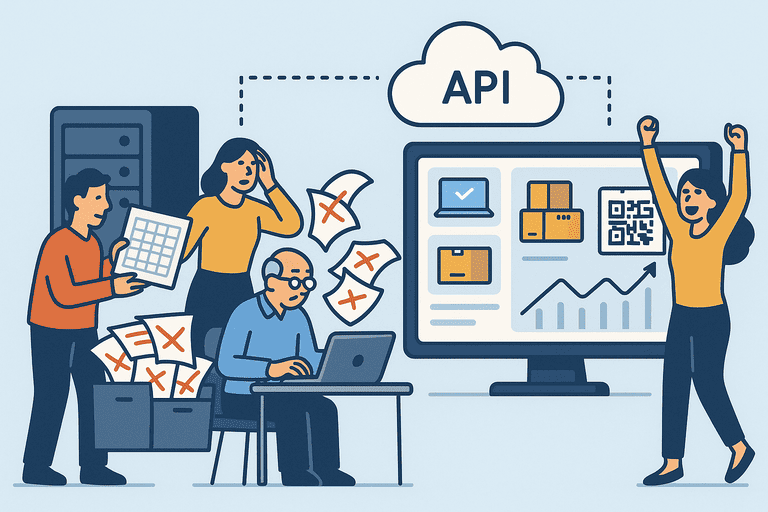Migrating from Legacy Systems to Modern Inventory Tools
Learn how to migrate from outdated inventory systems to modern, cloud-based tools without data loss, downtime, or employee confusion.

Introduction
Many organizations still rely on spreadsheets, on-premise software, or custom legacy tools to manage inventory. While these systems once served their purpose, they now create friction: poor data accuracy, limited scalability, and a lack of integration with other business systems.
Transitioning to a modern inventory platform is no longer optional — it’s a strategic move toward automation, visibility, and operational resilience.
This guide outlines a structured, low-risk migration process that helps you modernize effectively.
1. Why Legacy Inventory Systems Hold Businesses Back
Older systems often evolve organically, but over time they accumulate inefficiencies.
Common limitations include:
- Lack of real-time visibility or multi-location support
- Manual data entry leading to duplicate or inconsistent records
- No API integrations with finance, HR, or CRM tools
- Limited security, audit trails, or access control
- Poor user experience and steep training curves
These inefficiencies lead to invisible costs — delayed audits, asset misplacement, and unnecessary purchases.
2. Benefits of Modern Inventory Tools
Modern platforms offer flexibility and automation that legacy tools can’t match.
| Benefit | Description |
|---|---|
| Cloud access | Manage inventory anytime, anywhere |
| API & integrations | Connect with HR, accounting, and collaboration tools |
| Real-time tracking | Get up-to-date asset movement data |
| QR/NFC tagging | Fast, error-free identification |
| Security & compliance | Role-based permissions and audit logs |
| Automation | Alerts, reminders, and auto-reports |
Migrating doesn’t just replace software — it transforms how teams collaborate and make decisions.
3. Pre-Migration Assessment
Before migrating, take inventory (literally and figuratively) of your current setup.
Steps:
- List all data sources — spreadsheets, databases, ticketing tools.
- Identify ownership — who manages what and where inconsistencies exist.
- Define core entities — e.g., asset, category, location, user.
- Assess data quality — missing IDs, duplicates, or outdated assets.
- Map must-have integrations — like accounting or HR systems.
A clear audit helps ensure that only clean, structured data moves forward.
4. Data Mapping and Standardization
Modern tools expect normalized, validated data.
Tips for preparing your dataset:
- Use consistent formats for dates, IDs, and categories.
- Assign unique asset identifiers (QR, NFC, or barcode).
- Merge duplicates and verify ownership fields.
- Export sample data and test-import it into the new system.
- Validate location hierarchies and naming conventions.
Your goal is a single source of truth that future workflows can rely on.
5. Migration Strategies: Big Bang vs. Incremental
| Approach | Description | Best For |
|---|---|---|
| Big Bang | All data and operations switch over at once. | Small datasets, low risk systems |
| Incremental | Gradual migration per department or location. | Large or complex organizations |
In most cases, hybrid migration — running both systems in parallel during transition — provides the safest path.
It allows users to adapt and prevents workflow interruptions.
6. Change Management: Training and Communication
Technology alone doesn’t guarantee success.
Employees need clarity and confidence to adopt the new system.
Best practices:
- Communicate why the migration is happening and what problems it solves.
- Create role-specific onboarding guides.
- Provide training materials and Q&A sessions.
- Set up “champion users” in each department for support.
- Celebrate milestones (e.g., 1,000 assets successfully migrated).
User adoption is what turns a technical upgrade into an operational success.
7. Testing, Validation, and Go-Live
Before going fully live:
- Test imports with sample data.
- Validate permissions and access levels.
- Run parallel operations for a few cycles.
- Confirm reports match legacy results.
- Back up both systems before switching.
After migration, conduct a post-launch audit to verify data integrity and identify workflow gaps.
8. Post-Migration Optimization
Once live, use the new system’s analytics to uncover efficiencies:
- Identify underutilized assets.
- Optimize check-in/out workflows.
- Track recurring maintenance or loss patterns.
- Automate report generation for compliance.
Migration should be seen not as an endpoint, but as a foundation for continuous improvement.
9. Common Pitfalls to Avoid
❌ Migrating messy or unverified data.
❌ Skipping user training.
❌ Ignoring integration dependencies.
❌ Over-customizing before stabilization.
❌ Failing to archive historical records.
Every mistake compounds risk — build a checklist and stick to it.
Conclusion
Migrating from legacy to modern inventory systems is an investment in agility, accountability, and data accuracy.
A well-planned migration eliminates inefficiencies and positions your organization to scale confidently into the future.
When done right, modernization doesn’t just update software — it transforms how you manage your assets.
Explore related topics: